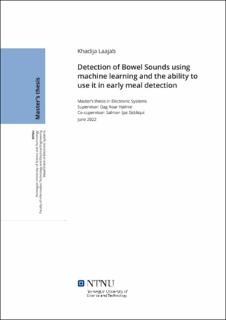| dc.description.abstract | Denne oppgaven beskriver implementering av en tarmlyddetektor ved bruk av maskinlæring og muligheten til å bruke det i tidlig måltidsdeteksjon. En slik metode kan brukes til å optimalisere avanserte glukosemålere, som for eksempel kontinuerlig glukosemåling (CGM) for diabetespasienter, slik at det ikke er behov for måltidskunngjøring, som er nødvendig i dag. Datasettene som ble brukt i denne oppgaven var åpent tilgjengelige opptak fra youtube og opptak levert av APT-gruppen. Det ble implementert to læringsmodeller med forskjellige datasett; den første ble tatt som utgangspunkt som inneholdt data fra youtube og den andre la innsamlet data til det første opprettede datasettet. Mel-skalert spektrogrammer ble brukt som egenskaper (eng. features), konvolusjonalt nevrale nettverk (CNN) ble valgt som læringsalgoritme og parameterjustering ble gjort for å finne best mulig ytelse. Modellene ble testet på testsettet og på innhentet opptak som presenterer en mer "reell tilstand" for å evaluere ytelsen. Den endelige modellen klarte å identifisere klassene BS og ikke-BS med en areal under "receiver operating characteristic curve" (AUC) på 95\%. Dette støtter tidligere funn som antyder muligheten for å skille mellom tarmlyd og ikke-tarmlyd. Detektoren er imidlertid ikke evaluert på kontaminerte opptak og bør fokuseres på i videre arbeid.
Den endelige implementerte tarmlyddetektoren ble brukt til å analysere ytterligere innsamlede opptak når forskjellige forsøkspersoner fulgte en gitt protokoll. Vanligvis var den detekterte tarmlyden hyppigere rett før eller/og under et måltid som støtter menneskets fysiologi. Dessuten ble de akustiske egenskapene spektralsentroide (SC), spektral båndbredde (SBW) og varigheten av den detekterte tarmlyden hentet ut fra de forskjellige tilstandene som ble fulgt i protokollene. Det ble ikke observert en spesiell trend i SC og SBW under faste- og spiseperioden. Imidlertid ble det observert ofte at varigheten av de oppdagede tarmlydene økte rett før eller/og under måltidsperioden. Den samme akustiske analysen ble gjort for å se om det var mulig å skille mellom et hardt og et mykt måltid. Den totale varigheten av de påviste tarmlydene per minutt var lengre når forsøkspersonene spiste et mykt måltid. SC og SBW hadde også en tendens til å være høyere når forsøkspersonene spiste hardt måltid og opptaket ble samlet inn fra venstre nedre kvadrant (LLQ) av abdomen. Noen av forsøkspersonene hadde en økning i forekomsten og varigheten av detektert tarmlyd mens de så matvideon, noe som betyr at det er behov for ytterligere akustisk analyse for å skille mellom tarmlydene funnet i denne tilstanden og de under måltidet. | |
| dc.description.abstract | This thesis describes the implementation of a bowel sound detector using machine learning and the ability to use it in early meal detection. Such a method can be used to optimize advanced glucose meters, such as continuous glucose monitoring (CGM) for diabetic patients so that there will be no need for meal announcements, which are necessary today. The data sets used in this thesis were openly available recordings from Youtube and recordings provided by the Artificial Pancreas Trondheim (APT) group. It was implemented two classifiers with different data sets; the first one was taken as a starting point which contained data from youtube and the second one added collected data to the first created data set. Mel-scaled spectrograms were used as features, the CNN was chosen as a classifier, and parameter tuning was done to find the best possible performance. The models were tested on the test set and on the collected recordings which presents a more ’real condition’ to evaluate its performance. The final created model managed to identify the classes, BS (bowel sound) and NBS (non-bowel sound) with an AUC of 95%. This supports previous findings that suggest the feasibility of distinguishing between bowel sound and nonbowel sound. However, the detector has not been evaluated on contaminated recordings and should be focused on in further work.
The final implemented bowel sound detector was used to analyze further collected recordings when different subjects followed a given protocol. Typically, the detected bowel sound was more frequent right before or/and during a meal which supports human physiology. Also, the acoustic features spectral centroid
(SC), spectral bandwidth (SBW), and the duration of the detected bowel sound were extracted from the different states followed in the protocols. It was not observed a particular trend in SC and SBW during the fasting and eating period. However, it was observed often, that the duration of the detected bowel sounds
increased right before or/and during the meal period. The same acoustic analysis was done to see if there was possible to differentiate between a hard meal and a soft meal. The total duration of the detected bowel sounds per minute was longer when the subjects ate a soft meal. Also, the SC and SBW tend to be higher when the subjects ate a hard meal and the recordings were collected from the left lower quadrant (LLQ). Some of the subjects, had an increase in the occurrence and duration of detected bowel sounds while watching food videos, meaning there is a need for further acoustic analysis to differentiate between the bowel sounds found in this state and the ones during the meal. | |
